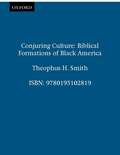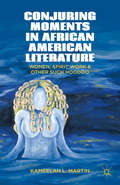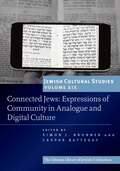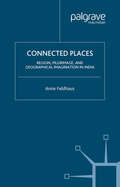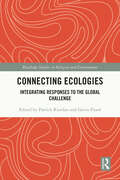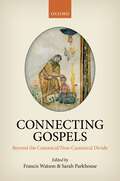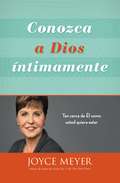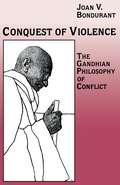- Table View
- List View
Conjunctive Explanations in Science and Religion (Routledge Science and Religion Series)
by David H. Glass Mikael Leidenhag David N. LivingstoneThis book investigates the nature and relevance of conjunctive explanations in the context of science and religion. It explores questions concerning how scientific and religious explanations for features of the world or phenomena within it relate to each other and whether they might work together in mutually enriching ways. The chapters address topics including the relationship between Darwinian and teleological explanations, non-reductive explanations of mind and consciousness, and explanations of Christian faith and religious experience, while others explore theological and philosophical issues concerning the nature and feasibility of conjunctive explanations. Overall, the contributions help to provide conceptual clarity on how scientific and religious explanations might or might not work together conjunctively as well as exploring how these ideas relate to specific topics in science and religion more generally.
Conjuring Culture: Biblical Formations of Black America (Religion in America)
by Theophus H. SmithThis book provides a sophisticated new interdisciplinary interpretation of the formulation and evolution of African American religion and culture. Theophus Smith argues for the central importance of "conjure"--a magical means of transforming reality--in black spirituality and culture. Smith shows that the Bible, the sacred text of Western civilization, has in fact functioned as a magical formulary for African Americans. Going back to slave religion, and continuing in black folk practice and literature to the present day, the Bible has provided African Americans with ritual prescriptions for prophetically re-envisioning, and thereby transforming, their history and culture. In effect the Bible is a "conjure book" for prescribing cures and curses, and for invoking extraordinary and Divine powers to effect changes in the conditions of human existence--and to bring about justice and freedom. Biblical themes, symbols, and figures like Moses, the Exodus, the Promised Land, and the Suffering Servant, as deployed by African Americans, have crucially formed and reformed not only black culture, but American society as a whole. Smith examines not only the religious and political uses of conjure, but its influence on black aesthetics, in music, drama, folklore, and literature. The concept of conjure, he shows, is at the heart of an indigenous and still vital spirituality, with exciting implications for reformulating the next generation of black studies and black theology. Even more broadly, Smith proposes, "conjuring culture" can function as a new paradigm for understanding Western religious and cultural phenomena generally.
Conjuring Moments in African American Literature: Women, Spirit Work, and Other Such Hoodoo
by K. Samuel Kameelah L. MartinThis book engages the ways African American authors have shifted, recycled, and reinvented the conjure woman in fiction. Kameelah Martin Samuel traces her presence and function in twentieth-century literature through historical records, oral histories, blues music, and collections of African American folklore.
Connect to Your Calling Digest
by T. D. JakesBestselling author Bishop T.D. Jakes shares this essential guide to recognizing, understanding, and utilizing your spiritual instincts to find God's calling in your life. Instant smash hit and #1 New York Times bestseller for six weeks, Bishop T.D. Jakes' Instinct showed readers how to tap into their intuition to achieve ultimate success. Now, you can apply those lessons with this collection, designed to encourage you on your faith journey. Combining social, business, and personal examples with biblical insights, this personal application guide will show you how to rediscover your natural aptitudes and reclaim the wisdom of past experiences. Knowing when to close a deal, when to take a risk, and when to listen to your heart will become possible when you're in touch with the instincts that God gave you. If you're ready to unlock your destiny and discover where you were meant to go, then this book is your key!
Connected Jews: Expressions of Community in Analogue and Digital Culture (Jewish Cultural Studies #6)
How Jews use media to connect with one another has profound consequences for Jewish identity, community, and culture. This volume explores how the use of media can both create communities and divide them because of how different media shape actions and project anxieties, conflicts, and emotions. Taken together, the essays presented here consider how Jewish use of media at home and in the street, as well as in the synagogue and in school, affects the individual’s sense of ethnic and religious affiliation. They include closely observed case studies, in various national contexts, of the role of popular film, television, records, the Internet, and smartphones, as well as the role of print media, now and historically. They raise fascinating questions about how Jews and Jewish institutions harness, tolerate, or resist media to create their sense of social belonging as Jews within the wider society.
Connected Places: Region, Pilgrimage, and Geographical Imagination in India (Religion/Culture/Critique)
by A. FeldhausThis book examines the words and actions of people who live in regions in the state of Maharashtra in Western India to illustrate the idea that regions are not only created by humans, but given meaning through religious practices. By exploring the people living in the area of Maharashtra, Feldhaus draws some very interesting conclusions about how people differentiate one region from others, and how we use stories, rituals, and ceremonies to recreate their importance. Feldhaus discovers that religious meanings attached to regions do not necessarily have a political teleology. According to Feldhaus, 'There is also a chance, even now, that religious imagery can enrich the lives of individuals and small communities without engendering bloodshed and hatred'.
Connecting Arts and Place: Cultural Policy and American Cities (Sociology of the Arts)
by Eleonora RedaelliIn this book, Eleonora Redaelli investigates the arts in American cities, providing insight into urban cultural policy discourse through the lens of space. By unpacking the ways in which scholars and policymakers account for geographic configuration and spatial relation, this monograph presents a unique approach to the arts and public policy. Redaelli analyses five main concepts of the international discourse in cultural policy — cultural planning, cultural mapping, creative industries, cultural districts and creative placemaking — highlighting how each of them contributes to the understanding of how the arts connect with place. Employing a selection of American cities as case, this book is an essential contribution to our understanding of cultural policy and its effects. It will be of interest to students and scholars of sociology, public policy, urban studies, arts management and cultural studies.
Connecting Ecologies: Integrating Responses to the Global Challenge (Routledge Studies in Religion and Environment)
by Gavin Flood Patrick RiordanConnecting Ecologies focuses on the environmental aspects of Pope Francis’ encyclical Laudato Si’ and the challenge to care for our common home. It considers how best to devise and implement the new societal models needed to tackle the ecological problems facing the world today. The book addresses the need for and complexity of an integral ecology, one that looks not only at physical and biological processes but also allows for the contributions of theology, philosophy, spirituality, and psychology, including the implications for the human and social sciences. The contributions document four categories of resonances, resources, requirements, and responses evoked by a reading of Laudato Si’ and include consideration of other faith traditions. They reflect on how care for our common home motivates people in different places, cultures, and professions to cooperate for myriad goods in common. The volume is particularly relevant for scholars working in religious studies and theology with an interest in ecology, the environment, and the Anthropocene.
Connecting Ecologies: Integrating Responses to the Global Challenge (Routledge Studies in Religion and Environment)
Connecting Ecologies focuses on the environmental aspects of Pope Francis’ encyclical Laudato Si’ and the challenge to care for our common home. It considers how best to devise and implement the new societal models needed to tackle the ecological problems facing the world today. The book addresses the need for and complexity of an integral ecology, one that looks not only at physical and biological processes but also allows for the contributions of theology, philosophy, spirituality, and psychology, including the implications for the human and social sciences. The contributions document four categories of resonances, resources, requirements, and responses evoked by a reading of Laudato Si’ and include consideration of other faith traditions. They reflect on how care for our common home motivates people in different places, cultures, and professions to cooperate for myriad goods in common. The volume is particularly relevant for scholars working in religious studies and theology with an interest in ecology, the environment, and the Anthropocene.
Connecting Gospels: Beyond the Canonical/Non-Canonical Divide
by Francis Watson Sarah ParkhouseBy the late second century, early Christian gospels had been divided into two groups by a canonical boundary that assigned normative status to four of them while consigning their competitors to the margins. Connecting Gospels: Beyond the Canonical/Non-canonical Divide finds new ways to reconnect these divided texts. Starting from the assumption that, in spite of their differences, all early gospels express a common belief in the absolute significance of Jesus and his earthly career, this authoritative collection makes their interconnectedness fruitful for interpretation. The contributors have each selected a theme or topic and trace it across two or more gospels on either side of the canonical boundary, and the resulting convergences and divergences shed light not least on the canonical texts themselves as they are read from new and unfamiliar vantage points. This volume demonstrates that early gospel literature can be regarded as a single field of study, in contrast to the overwhelming predominance of the canonical four characteristic of traditional gospels scholarship.
Connecting Gospels: Beyond the Canonical/Non-Canonical Divide
By the late second century, early Christian gospels had been divided into two groups by a canonical boundary that assigned normative status to four of them while consigning their competitors to the margins. Connecting Gospels: Beyond the Canonical/Non-canonical Divide finds new ways to reconnect these divided texts. Starting from the assumption that, in spite of their differences, all early gospels express a common belief in the absolute significance of Jesus and his earthly career, this authoritative collection makes their interconnectedness fruitful for interpretation. The contributors have each selected a theme or topic and trace it across two or more gospels on either side of the canonical boundary, and the resulting convergences and divergences shed light not least on the canonical texts themselves as they are read from new and unfamiliar vantage points. This volume demonstrates that early gospel literature can be regarded as a single field of study, in contrast to the overwhelming predominance of the canonical four characteristic of traditional gospels scholarship.
Connecting the Isiac Cults: Formal Modeling in the Hellenistic Mediterranean (Scientific Studies of Religion: Inquiry and Explanation)
by Tomáš GlombWhy did Egyptian cults, especially those dedicated to the goddess Isis and god Sarapis, spread so successfully across the ancient Mediterranean after the death of Alexander the Great? How are we limited by the established methodological apparatus of historiography and which innovative methods from other disciplines can overcome these limits? In this book, Tomáš Glomb shows that while the interplay of different factors such as the economy, climate, and politics created favorable conditions for the early spread of the Isiac cults, the use of innovative quantitative methods can shed new light and help disentangle the complex interplay of individual factors. Using a combination of geospatial modeling, mathematical modeling, and network analysis, Glomb determines that, at least in the regions of the Hellenistic Aegean and western Asia Minor, the political channels created by the Ptolemaic dynasty were a dominant force in the local spread of the Isiac cults. An important contribution to the historiography of the ancient Mediterranean, this book answers the specific question of “how it happened” as well as, “how can we answer it beyond the limits of the established methodological apparatus in historiography.”
Connecting the Isiac Cults: Formal Modeling in the Hellenistic Mediterranean (Scientific Studies of Religion: Inquiry and Explanation)
by Tomáš GlombWhy did Egyptian cults, especially those dedicated to the goddess Isis and god Sarapis, spread so successfully across the ancient Mediterranean after the death of Alexander the Great? How are we limited by the established methodological apparatus of historiography and which innovative methods from other disciplines can overcome these limits? In this book, Tomáš Glomb shows that while the interplay of different factors such as the economy, climate, and politics created favorable conditions for the early spread of the Isiac cults, the use of innovative quantitative methods can shed new light and help disentangle the complex interplay of individual factors. Using a combination of geospatial modeling, mathematical modeling, and network analysis, Glomb determines that, at least in the regions of the Hellenistic Aegean and western Asia Minor, the political channels created by the Ptolemaic dynasty were a dominant force in the local spread of the Isiac cults. An important contribution to the historiography of the ancient Mediterranean, this book answers the specific question of “how it happened” as well as, “how can we answer it beyond the limits of the established methodological apparatus in historiography.”
The Connexion 23: Be Bold (the connexion #23)
by The Methodist Church in Britainthe connexion is a free magazine about the life and work of the Methodist Church, bringing together inspirational stories from Methodist people who are passionate about sharing God’s love to change lives.
Conozca a Dios íntimamente: Tan cerca de Él como usted quiera estar
by Joyce MeyerSi usted está en búsqueda de Dios, o si es un creyente que siente que le falta algo, Joyce Meyer, la autora de éxitos de ventas número 1 del New York Times, quiere mostrarle cómo experimentar el gozo profundo que proviene de una relación verdaderamente íntima con Dios.Utilizando la Escritura y ejemplos poderosos de la vida real, Joyce revela maneras prácticas donde usted puede crecer más cerca de Dios a través de su relación personal con Él. Para lograrlo, ella ofrece una imagen clara de cuatro niveles de intimidad que usted puede experimentar. En cada nivel, desde reconocer la presencia de Dios hasta dejar que su amor transforme su vida por completo, Joyce muestra cómo moverse, paso a paso, más cerca de Dios y descubrir todo lo que Él tiene para usted.¿Está tan cerca de Dios como quiere estar? ¿Quiere saber qué tan profundo puede llegar en su relación con Él? En CONOZCA A DIOS ÍNTIMAMENTE, Joyce Meyer le da las claves para tener una verdadera intimidad con Él todos los días, en cada área de su vida. Él está esperando; la decisión es suya. ¿Abrirá usted la puerta?
Conozca a Dios íntimamente: Tan cerca de Él como usted quiera estar
by Joyce MeyerSi usted está en búsqueda de Dios, o si es un creyente que siente que le falta algo, Joyce Meyer, la autora de éxitos de ventas número 1 del New York Times, quiere mostrarle cómo experimentar el gozo profundo que proviene de una relación verdaderamente íntima con Dios.Utilizando la Escritura y ejemplos poderosos de la vida real, Joyce revela maneras prácticas donde usted puede crecer más cerca de Dios a través de su relación personal con Él. Para lograrlo, ella ofrece una imagen clara de cuatro niveles de intimidad que usted puede experimentar. En cada nivel, desde reconocer la presencia de Dios hasta dejar que su amor transforme su vida por completo, Joyce muestra cómo moverse, paso a paso, más cerca de Dios y descubrir todo lo que Él tiene para usted.¿Está tan cerca de Dios como quiere estar? ¿Quiere saber qué tan profundo puede llegar en su relación con Él? En CONOZCA A DIOS ÍNTIMAMENTE, Joyce Meyer le da las claves para tener una verdadera intimidad con Él todos los días, en cada área de su vida. Él está esperando; la decisión es suya. ¿Abrirá usted la puerta?
Conquering Character: The Characterization of Joshua in Joshua 1-11 (The Library of Hebrew Bible/Old Testament Studies)
by Sarah Lebhar HallWhile recent Old Testament scholarship has seen a steady rise in the prominence of narrative approaches to the text, little such work has been done on the book of Joshua. This book offers a narrative treatment of the conquest accounts, with specific attention given to the characterization of Joshua. The method employed is eclectic, including poetic analysis, structural study, delimitation criticism, comparative literary analysis, and intertextual reading. Joshua's characterization has received inadequate scholarly attention to date, largely because he is seen as a pale character, a mere stereotype in the biblical history. This two-dimensional reading often leads to the conclusion that Joshua is meant to represent another character in the history. But this approach neglects the many aspects of Joshua's character that are unique, and does not address the text's presentation of his flaws. On the other hand, some scholars have recently suggested that Joshua's character is significantly flawed. This reading is similarly untenable, as those features of Joshua's leadership that it portrays as faulty are in fact condoned, not condemned, by the text itself. Close examination of the conquest narratives suggests that Joshua's character is both complex and reliable. To the degree that Joshua functions as a paradigm in the subsequent histories, this paradigm must be conceived more broadly than it has been in the past. He is not merely a royal, prophetic, or priestly figure, but exercises, and often exemplifies, the many different types of leadership that feature in the former prophets.
Conquest and Community: The Afterlife of Warrior Saint Ghazi Miyan
by Shahid AminFew topics in South Asian history are as contentious as that of the Turkic conquest of the Indian subcontinent that began in the twelfth century and led to a long period of Muslim rule. How is a historian supposed to write honestly about the bloody history of the conquest without falling into communitarian traps? Conquest and Community is Shahid Amin's answer. Covering more than eight hundred years of history, the book centers on the enduringly popular saint Ghazi Miyan, a youthful soldier of Islam whose shrines are found all over India. Amin details the warrior saint’s legendary exploits, then tracks the many ways he has been commemorated in the centuries since. The intriguing stories, ballads, and proverbs that grew up around Ghazi Miyan were, Amin shows, a way of domesticating the conquest—recognizing past conflicts and differences but nevertheless bringing diverse groups together into a community of devotees. What seems at first glance to be the story of one mythical figure becomes an allegory for the history of Hindu-Muslim relations over an astonishingly long period of time, and a timely contribution to current political and historical debates.
Conquest and Community: The Afterlife of Warrior Saint Ghazi Miyan
by Shahid AminFew topics in South Asian history are as contentious as that of the Turkic conquest of the Indian subcontinent that began in the twelfth century and led to a long period of Muslim rule. How is a historian supposed to write honestly about the bloody history of the conquest without falling into communitarian traps? Conquest and Community is Shahid Amin's answer. Covering more than eight hundred years of history, the book centers on the enduringly popular saint Ghazi Miyan, a youthful soldier of Islam whose shrines are found all over India. Amin details the warrior saint’s legendary exploits, then tracks the many ways he has been commemorated in the centuries since. The intriguing stories, ballads, and proverbs that grew up around Ghazi Miyan were, Amin shows, a way of domesticating the conquest—recognizing past conflicts and differences but nevertheless bringing diverse groups together into a community of devotees. What seems at first glance to be the story of one mythical figure becomes an allegory for the history of Hindu-Muslim relations over an astonishingly long period of time, and a timely contribution to current political and historical debates.
Conquest and Community: The Afterlife of Warrior Saint Ghazi Miyan
by Shahid AminFew topics in South Asian history are as contentious as that of the Turkic conquest of the Indian subcontinent that began in the twelfth century and led to a long period of Muslim rule. How is a historian supposed to write honestly about the bloody history of the conquest without falling into communitarian traps? Conquest and Community is Shahid Amin's answer. Covering more than eight hundred years of history, the book centers on the enduringly popular saint Ghazi Miyan, a youthful soldier of Islam whose shrines are found all over India. Amin details the warrior saint’s legendary exploits, then tracks the many ways he has been commemorated in the centuries since. The intriguing stories, ballads, and proverbs that grew up around Ghazi Miyan were, Amin shows, a way of domesticating the conquest—recognizing past conflicts and differences but nevertheless bringing diverse groups together into a community of devotees. What seems at first glance to be the story of one mythical figure becomes an allegory for the history of Hindu-Muslim relations over an astonishingly long period of time, and a timely contribution to current political and historical debates.
Conquest and Community: The Afterlife of Warrior Saint Ghazi Miyan
by Shahid AminFew topics in South Asian history are as contentious as that of the Turkic conquest of the Indian subcontinent that began in the twelfth century and led to a long period of Muslim rule. How is a historian supposed to write honestly about the bloody history of the conquest without falling into communitarian traps? Conquest and Community is Shahid Amin's answer. Covering more than eight hundred years of history, the book centers on the enduringly popular saint Ghazi Miyan, a youthful soldier of Islam whose shrines are found all over India. Amin details the warrior saint’s legendary exploits, then tracks the many ways he has been commemorated in the centuries since. The intriguing stories, ballads, and proverbs that grew up around Ghazi Miyan were, Amin shows, a way of domesticating the conquest—recognizing past conflicts and differences but nevertheless bringing diverse groups together into a community of devotees. What seems at first glance to be the story of one mythical figure becomes an allegory for the history of Hindu-Muslim relations over an astonishingly long period of time, and a timely contribution to current political and historical debates.
Conquest and Community: The Afterlife of Warrior Saint Ghazi Miyan
by Shahid AminFew topics in South Asian history are as contentious as that of the Turkic conquest of the Indian subcontinent that began in the twelfth century and led to a long period of Muslim rule. How is a historian supposed to write honestly about the bloody history of the conquest without falling into communitarian traps? Conquest and Community is Shahid Amin's answer. Covering more than eight hundred years of history, the book centers on the enduringly popular saint Ghazi Miyan, a youthful soldier of Islam whose shrines are found all over India. Amin details the warrior saint’s legendary exploits, then tracks the many ways he has been commemorated in the centuries since. The intriguing stories, ballads, and proverbs that grew up around Ghazi Miyan were, Amin shows, a way of domesticating the conquest—recognizing past conflicts and differences but nevertheless bringing diverse groups together into a community of devotees. What seems at first glance to be the story of one mythical figure becomes an allegory for the history of Hindu-Muslim relations over an astonishingly long period of time, and a timely contribution to current political and historical debates.
Conquest and Community: The Afterlife of Warrior Saint Ghazi Miyan
by Shahid AminFew topics in South Asian history are as contentious as that of the Turkic conquest of the Indian subcontinent that began in the twelfth century and led to a long period of Muslim rule. How is a historian supposed to write honestly about the bloody history of the conquest without falling into communitarian traps? Conquest and Community is Shahid Amin's answer. Covering more than eight hundred years of history, the book centers on the enduringly popular saint Ghazi Miyan, a youthful soldier of Islam whose shrines are found all over India. Amin details the warrior saint’s legendary exploits, then tracks the many ways he has been commemorated in the centuries since. The intriguing stories, ballads, and proverbs that grew up around Ghazi Miyan were, Amin shows, a way of domesticating the conquest—recognizing past conflicts and differences but nevertheless bringing diverse groups together into a community of devotees. What seems at first glance to be the story of one mythical figure becomes an allegory for the history of Hindu-Muslim relations over an astonishingly long period of time, and a timely contribution to current political and historical debates.
Conquest of Violence: The Gandhian Philosophy of Conflict. With a new epilogue by the author (PDF)
by Joan Valerie BondurantWhen Mahatma Gandhi died in 1948 by an assassin's bullet, the most potent legacy he left to the world was the technique of satyagraha (literally, holding on to the Truth). His "experiments with Truth" were far from complete at the time of his death, but he had developed a new technique for effecting social and political change through the constructive conduct of conflict: Gandhian satyagraha had become eminently more than "passive resistance" or "civil disobedience." By relating what Gandhi said to what he did and by examining instances of satyagraha led by others, this book abstracts from the Indian experiments those essential elements that constitute the Gandhian technique. It explores, in terms familiar to the Western reader, its distinguishing characteristics and its far-reaching implications for social and political philosophy.
Conquest of Violence: The Gandhian Philosophy of Conflict. With a new epilogue by the author
by Joan Valerie BondurantWhen Mahatma Gandhi died in 1948 by an assassin's bullet, the most potent legacy he left to the world was the technique of satyagraha (literally, holding on to the Truth). His "experiments with Truth" were far from complete at the time of his death, but he had developed a new technique for effecting social and political change through the constructive conduct of conflict: Gandhian satyagraha had become eminently more than "passive resistance" or "civil disobedience." By relating what Gandhi said to what he did and by examining instances of satyagraha led by others, this book abstracts from the Indian experiments those essential elements that constitute the Gandhian technique. It explores, in terms familiar to the Western reader, its distinguishing characteristics and its far-reaching implications for social and political philosophy.

